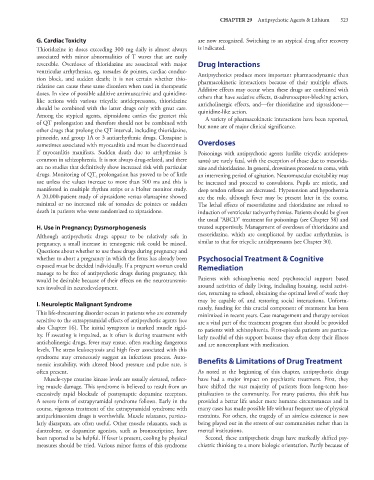Page 537 - Basic _ Clinical Pharmacology ( PDFDrive )
P. 537
CHAPTER 29 Antipsychotic Agents & Lithium 523
G. Cardiac Toxicity are now recognized. Switching to an atypical drug after recovery
Thioridazine in doses exceeding 300 mg daily is almost always is indicated.
associated with minor abnormalities of T waves that are easily
reversible. Overdoses of thioridazine are associated with major Drug Interactions
ventricular arrhythmias, eg, torsades de pointes, cardiac conduc- Antipsychotics produce more important pharmacodynamic than
tion block, and sudden death; it is not certain whether thio- pharmacokinetic interactions because of their multiple effects.
ridazine can cause these same disorders when used in therapeutic Additive effects may occur when these drugs are combined with
doses. In view of possible additive antimuscarinic and quinidine- others that have sedative effects, α-adrenoceptor-blocking action,
like actions with various tricyclic antidepressants, thioridazine anticholinergic effects, and—for thioridazine and ziprasidone—
should be combined with the latter drugs only with great care. quinidine-like action.
Among the atypical agents, ziprasidone carries the greatest risk A variety of pharmacokinetic interactions have been reported,
of QT prolongation and therefore should not be combined with but none are of major clinical significance.
other drugs that prolong the QT interval, including thioridazine,
pimozide, and group 1A or 3 antiarrhythmic drugs. Clozapine is
sometimes associated with myocarditis and must be discontinued Overdoses
if myocarditis manifests. Sudden death due to arrhythmias is Poisonings with antipsychotic agents (unlike tricyclic antidepres-
common in schizophrenia. It is not always drug-related, and there sants) are rarely fatal, with the exception of those due to mesorida-
are no studies that definitively show increased risk with particular zine and thioridazine. In general, drowsiness proceeds to coma, with
drugs. Monitoring of QT prolongation has proved to be of little an intervening period of agitation. Neuromuscular excitability may
c
use unless the values increase to more than 500 ms and this is be increased and proceed to convulsions. Pupils are miotic, and
manifested in multiple rhythm strips or a Holter monitor study. deep tendon reflexes are decreased. Hypotension and hypothermia
A 20,000-patient study of ziprasidone versus olanzapine showed are the rule, although fever may be present later in the course.
minimal or no increased risk of torsades de pointes or sudden The lethal effects of mesoridazine and thioridazine are related to
death in patients who were randomized to ziprasidone. induction of ventricular tachyarrhythmias. Patients should be given
the usual “ABCD” treatment for poisonings (see Chapter 58) and
H. Use in Pregnancy; Dysmorphogenesis treated supportively. Management of overdoses of thioridazine and
Although antipsychotic drugs appear to be relatively safe in mesoridazine, which are complicated by cardiac arrhythmias, is
pregnancy, a small increase in teratogenic risk could be missed. similar to that for tricyclic antidepressants (see Chapter 30).
Questions about whether to use these drugs during pregnancy and
whether to abort a pregnancy in which the fetus has already been Psychosocial Treatment & Cognitive
exposed must be decided individually. If a pregnant woman could Remediation
manage to be free of antipsychotic drugs during pregnancy, this
would be desirable because of their effects on the neurotransmit- Patients with schizophrenia need psychosocial support based
ters involved in neurodevelopment. around activities of daily living, including housing, social activi-
ties, returning to school, obtaining the optimal level of work they
may be capable of, and restoring social interactions. Unfortu-
I. Neuroleptic Malignant Syndrome nately, funding for this crucial component of treatment has been
This life-threatening disorder occurs in patients who are extremely minimized in recent years. Case management and therapy services
sensitive to the extrapyramidal effects of antipsychotic agents (see are a vital part of the treatment program that should be provided
also Chapter 16). The initial symptom is marked muscle rigid- to patients with schizophrenia. First-episode patients are particu-
ity. If sweating is impaired, as it often is during treatment with larly needful of this support because they often deny their illness
anticholinergic drugs, fever may ensue, often reaching dangerous and are noncompliant with medication.
levels. The stress leukocytosis and high fever associated with this
syndrome may erroneously suggest an infectious process. Auto- Benefits & Limitations of Drug Treatment
nomic instability, with altered blood pressure and pulse rate, is
often present. As noted at the beginning of this chapter, antipsychotic drugs
Muscle-type creatine kinase levels are usually elevated, reflect- have had a major impact on psychiatric treatment. First, they
ing muscle damage. This syndrome is believed to result from an have shifted the vast majority of patients from long-term hos-
excessively rapid blockade of postsynaptic dopamine receptors. pitalization to the community. For many patients, this shift has
A severe form of extrapyramidal syndrome follows. Early in the provided a better life under more humane circumstances and in
course, vigorous treatment of the extrapyramidal syndrome with many cases has made possible life without frequent use of physical
antiparkinsonism drugs is worthwhile. Muscle relaxants, particu- restraints. For others, the tragedy of an aimless existence is now
larly diazepam, are often useful. Other muscle relaxants, such as being played out in the streets of our communities rather than in
dantrolene, or dopamine agonists, such as bromocriptine, have mental institutions.
been reported to be helpful. If fever is present, cooling by physical Second, these antipsychotic drugs have markedly shifted psy-
measures should be tried. Various minor forms of this syndrome chiatric thinking to a more biologic orientation. Partly because of

